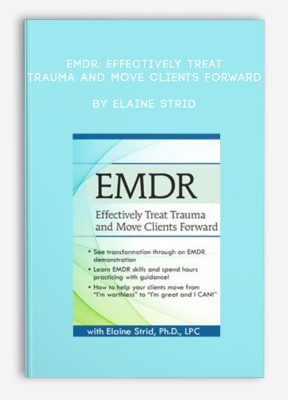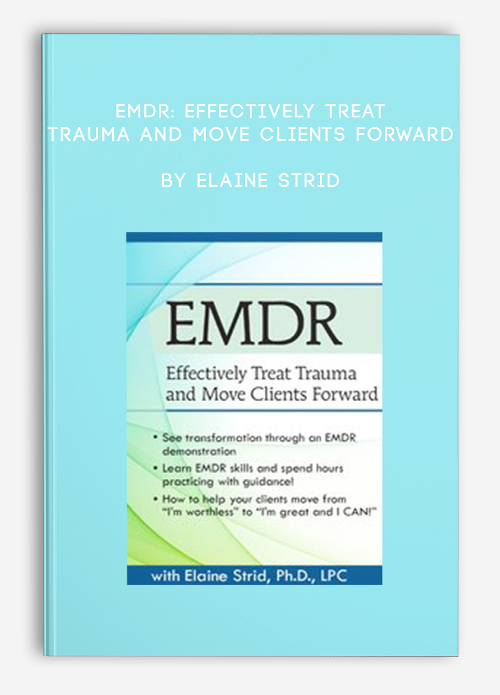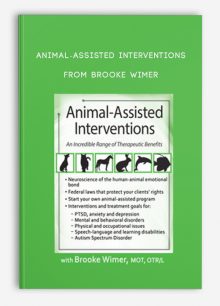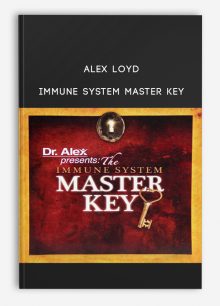EMDR: Effectively Treat Trauma and Move Clients Forward by Elaine Strid
$439.99 $125.00

EMDR: Effectively Treat Trauma and Move Clients Forward by Elaine Strid
**More information:
Get EMDR: Effectively Treat Trauma and Move Clients Forward at Salaedu.com
Description
- See transformation through an EMDR demonstration
- Learn EMDR skills and spend hours practicing with guidance!
- How to help your clients move from “I’m worthless” to “I’m great and I CAN!”
If you’ve heard of EMDR (Eye Movement Desensitization and Reprocessing), you know it works to heal trauma and you want to know more, this workshop is for you! Attend this unique workshop and learn essential information you need to know about EMDR.
Dr. Elaine Strid, EMDR-Trained Therapist, will first teach you about EMDR and the neurobiology of how EMDR can change the brain. Then she will do a complete live demonstration so you can see EMDR in action!
In this unique EMDR workshop, you will understand the benefit of EMDR and the impact it can have on your clinical work. You will also learn the 8 Stages of EMDR Therapy and have more than three hours of practice time with some the foundational EMDR skills.
Dr. Strid hears often from fellow trauma clinicians that they do a great job working with clients to cope better with trauma; however, clients claim that they feel “filthy and powerless” about themselves. Elaine will show you how EMDR can help clients move forward to truly heal from the inside out and how to live a fulfilling life again.
EMDR & How it Changes the Brain
- Definition: Origin from Francine Shapiro
- Purpose in resolution of trauma
- How EMDR rewires the brain
- Neurobiology
EMDR 8 Stages Protocol and More
- Get the client ready for EMDR
- Identify and explain the 8 Stages
- How to handle dissociation
- Checking the safety in the safe place
- SUDs (Subjective Units of Distress)
- Negative and positive cognition
- Installing the positive
- Using body scans
- Being very present and aware of your client
- Re-evaluation
- What to do when things aren’t working well
EMDR Techniques for You and Your Clients
- Safe place techniques for clients outside of therapy
- EMDR when flashbacks happen
- Butterfly hug
- Hot water bath
- Self-tapping
- Foot in shoe tapping
- Breathing out the bad, In with the good
Teaching EMDR Techniques to Clients
- Entry level – benefits to develop safety to use in session
- Add to the client’s toolbox while trauma resolution is occurring
- Develop the client into 3 confidence levels using EMDR techniques:
- Safety with self
- Safety with others they are close to
- Safety with strangers & general safety in public
Importance of Positive EMDR/Positive Cognition Reinforcement
- Practice counselor confidence with EMDR
- Find where the deficits are
- Build self-control, confidence and character traits in your clients
- Help clients develop skills in maturity in relationships
- Help them become more self-aware
- Somatization awareness
- Emotional shutdowns
- Inability to bond
- Build self-value in clients
- Bonding/attachment skills
- Confidence in goal setting
- Capabilities to say no/yes to their dreams
How to Pair EMDR with Other Therapies
- Research base for using EMDR with other therapy techniques
- CBT
- Mindfulness
- Gestalt
- Pet/Equine
EMDR in Action- Practice Throughout Both Days
- Watch a transformation via an EMDR demonstration
- Practice with questions and body scanning
- Practice of positive cognition and new brain traits
- Use EMDR in fear situations
- EMDR for confidence building
- Restore Self from Compassion Fatigue for yourself
Where to Go from Here?
- EMDRIA Certification guidelines and information
- More intensive EMDR trainings
- Other EMDR resources
More information about Medical:
Medicine is the science and practice of establishing the diagnosis, prognosis, treatment, and prevention of disease.
Medicine encompasses a variety of health care practices evolved to maintain and restore health by the prevention and treatment of illness.
Contemporary medicine applies biomedical sciences, biomedical research, genetics, and medical technology to diagnose, treat, and prevent injury and disease,
typically through pharmaceuticals or surgery, but also through therapies as diverse as psychotherapy, external splints and traction, medical devices, biologics, and ionizing radiation, amongst others.
Medicine has been around for thousands of years, during most of which it was an art (an area of skill and knowledge) frequently having connections to the religious and
philosophical beliefs of local culture. For example, a medicine man would apply herbs and say prayers for healing, or an ancient philosopher and physician would apply bloodletting according to the theories of humorism.
In recent centuries, since the advent of modern science, most medicine has become a combination of art and science (both basic and applied, under the umbrella of medical science).
While stitching technique for sutures is an art learned through practice, the knowledge of what happens at the cellular and molecular level in the tissues being stitched arises through science.
1 review for EMDR: Effectively Treat Trauma and Move Clients Forward by Elaine Strid
Add a review Cancel reply
Related products
HEALTH - FITNESS - LIFESTYLE - MEDICAL
HEALTH - FITNESS - LIFESTYLE - MEDICAL
HEALTH - FITNESS - LIFESTYLE - MEDICAL
HEALTH - FITNESS - LIFESTYLE - MEDICAL
Fitness Mentors – Audio Lectures, Practice Tests and Study Guide for the NASM CPT Ex
HEALTH - FITNESS - LIFESTYLE - MEDICAL
HEALTH - FITNESS - LIFESTYLE - MEDICAL
Fast Confidence [How To Be More Confident │Confidence Building] from Sharon Melnick, Ph.D.
HEALTH - FITNESS - LIFESTYLE - MEDICAL
HEALTH - FITNESS - LIFESTYLE - MEDICAL







![Fast Confidence [How To Be More Confident │Confidence Building] from Sharon Melnick, Ph.D.](https://tradersoffer.forex/wp-content/uploads/2017/05/Sharon-Melnick-Ph.D.-Fast-Confidence-How-To-Be-More-Confident-│Confidence-Building-220x261.png)


Trevis Trevis –
Welcome to Sala Shop, we are here to provide everything to learn and improve this life…encourage you to check clearly the course